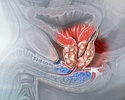Prostate brachytherapy
Implant therapy - prostate cancer; Radioactive seed placement; Internal radiation therapy - prostate; High dose radiation (HDR)
Brachytherapy is a procedure to implant radioactive seeds (pellets) into the prostate gland to kill prostate cancer cells. The seeds may give off high or low amounts of radiation.
Description
Brachytherapy takes 30 minutes or more, depending on the type of therapy you have. Before the procedure, you will be given medicine so that you do not feel pain. You may receive:
- A sedative to make you drowsy and numbing medicine on your perineum. This is the area between the anus and scrotum.
- Anesthesia: With spinal anesthesia, you will be drowsy but awake, and numb below the waist. With general anesthesia, you will be asleep and pain free.
After you receive anesthesia:
- The doctor places an ultrasound probe into your rectum to view the area. The probe is like a camera connected to a video monitor in the room. A catheter (tube) may be placed in your bladder to drain urine.
- The doctor uses ultrasound or a CT scan to plan and then place the seeds that deliver radiation into your prostate. The seeds are placed with needles or special applicators through your perineum.
- Placing the seeds may hurt a little (if you are awake).
Types of brachytherapy:
- Low-dose rate brachytherapy is the most common type of treatment. The seeds stay inside your prostate and put out a small amount of radiation for several months. You go about your normal routine with the seeds in place.
- High-dose rate brachytherapy lasts about 30 minutes. Your doctor inserts the radioactive material into the prostate. The doctor may use a computerized robot to do this. The radioactive material is removed right away after treatment. This method often requires 2 treatments spaced 1 week apart.
Why the Procedure Is Performed
Brachytherapy is often used for men with prostate cancer that is found early and is slow-growing. Brachytherapy has fewer complications and side effects than standard radiation therapy. You will also need fewer visits with the health care provider.
Risks
Risks of any anesthesia are:
- Allergic reactions to medicines
- Breathing problems
Risks of any surgery are:
- Bleeding
- Infection
Risks of this procedure are:
- Impotence
- Difficulty emptying your bladder, and the need to use a catheter
- Rectal urgency, or the feeling that you need to have a bowel movement right away
- Skin irritation in your rectum or bleeding from your rectum
- Other urinary problems
- Ulcers (sores) or a fistula (abnormal passage) in the rectum, scarring and narrowing of the urethra (all of these are rare)
Before the Procedure
Tell your provider what medicines you are taking. These include medicines, supplements, or herbs you bought without a prescription.
Before this procedure:
- You may need to have ultrasounds, x-rays, or CT scans to prepare for the procedure.
- Several days before the procedure, you may be told to stop taking medicines that make it hard for your blood to clot. These medicines include aspirin, ibuprofen (Advil, Motrin), naproxen (Aleve, Naprosyn), vitamin E, clopidogrel (Plavix), and warfarin (Coumadin).
- Ask which medicines you should still take on the day of the surgery.
- If you smoke, try to stop. Your provider can help.
On the day of the procedure:
- You will likely be asked not to drink or eat anything for several hours before the procedure.
- Take the medicines you've been told to take with a small sip of water.
- You will be told when to arrive at the hospital. Be sure to arrive on time.
After the Procedure
You may be sleepy and have mild pain and tenderness after the procedure.
After an outpatient procedure, you can go home as soon as the anesthesia wears off. In rare cases, you will need to spend 1 to 2 days in the hospital. If you stay in the hospital, your visitors will need to follow special radiation safety precautions.
If you have a permanent implant, your provider may tell you to limit the amount of time you spend around children and women who are pregnant. After a few weeks to months, the radiation is gone and will not cause any harm. Because of this, there is no need to take out the seeds.
Outlook (Prognosis)
Most men with small, slow-growing prostate cancer remain cancer-free or their cancer is in good control for many years after this treatment. Urinary and rectal symptoms may last for months or years.
References
Nelson WG, Antonarakis ES, Carter HB, De Marzo AM, DeWeese TL. Prostate cancer. In: Niederhuber JE, Armitage JO, Kastan MB, Doroshow JH, Tepper JE, eds. Abeloff's Clinical Oncology. 6th ed. Philadelphia, PA: Elsevier; 2020:chap 81.
Phillips R, Hazell S, Song DY. Radiation therapy for prostate cancer. In: Partin AW, Dmochowski RR, Kavoussi LR, Peters CA, eds. Campbell-Walsh-Wein Urology. 12th ed. Philadelphia, PA: Elsevier; 2021:chap 157.
US National Library of Medicine, PubMed website. PDQ Adult Treatment Editorial Board. Prostate cancer treatment (PDQ): health professional version. Bethesda, MD: National Cancer Institute. www.cancer.gov/types/prostate/hp/prostate-treatment-pdq. Updated October 14, 2022. Accessed February 5, 2023.
Review Date: 1/1/2023
Reviewed By: Kelly L. Stratton, MD, FACS, Associate Professor, Department of Urology, University of Oklahoma Health Sciences Center, Oklahoma City, OK. Also reviewed by David C. Dugdale, MD, Medical Director, Brenda Conaway, Editorial Director, and the A.D.A.M. Editorial team.


